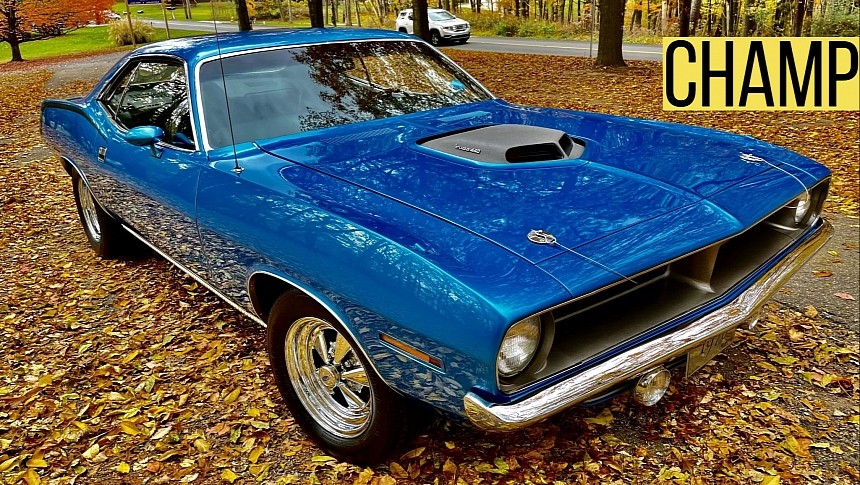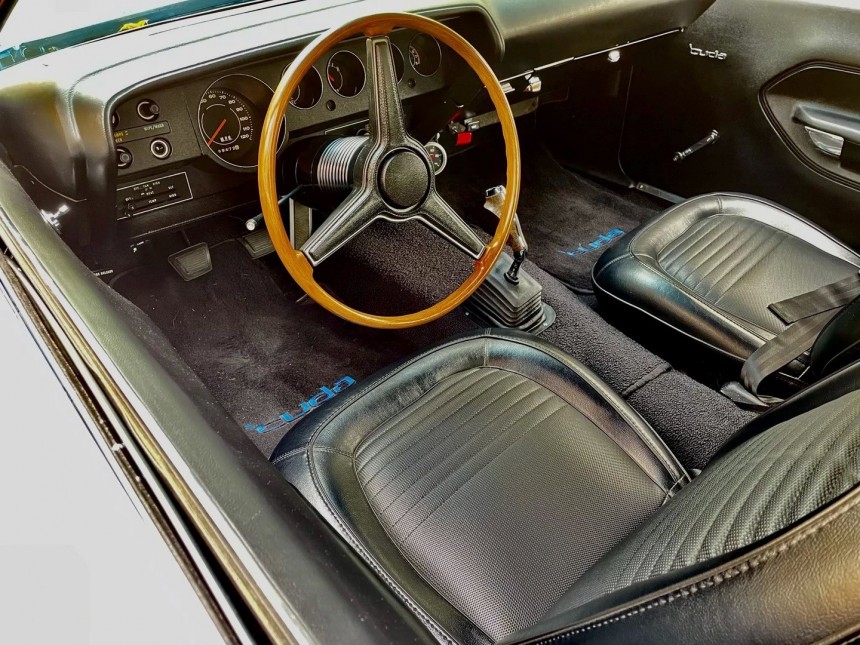When it comes to the Plymouth Barracuda, you might as well ignore the first two generations and focus on the third, because that was the only truly special version they made. It was based on the E-body platform and featured a completely new design compared to its predecessor.
The E-body Barracuda was designed by the talented John E. Herlitz, and while it shared the same platform as the Dodge Challenger, the two iconic muscle cars never featured any interchangeable sheet metal, which is to be appreciated. Furthermore, the Barracuda was slightly smaller than the Challenger, and it even weighed less, which is never irrelevant in this industry.
Now, the car you’re looking at here is a 1970 Barracuda coupe, which started life powered by the lowly 318 ci V8, which was only ever good for 230 horsepower. It wasn’t horrible, but it wasn’t impressive either.
Luckily, a replacement 440 ci V8 was installed by the previous owner, featuring a Holley HP four-barrel carburetor, an Edelbrock intake manifold, Edelbrock aluminum cylinder heads, a Comp Cams camshaft, TTI ceramic-coated exhaust headers, and MSD ignition components. Originally, this engine would have put down 375 horsepower, but in this case we’re not exactly sure what the peak output figure is.
Anyway, however much power it’s got, it all goes to the rear wheels via a four-speed manual gearbox, while the soundtrack is managed by a stainless-steel dual-exhaust system. Oh, and yes, the car is up for grabs to the highest bidder, and with only 2 days left to go in the auction process, interested parties better hurry.
Moving on to the visuals, this Barracuda is still wearing the same Blue Fire Metallic hue it left the factory with, albeit it was repainted under previous ownership some 10 years ago.
Other exterior highlights include the metallic gray shaker hood scoop, hood pins, black 440 ‘hockey stick’ stripes, ‘Cuda badging, a satin-gray metallic grille, black tail panel, fender-mounted turn signal indicators, body-color mirrors, 1970-style fish gill rocker moldings, chrome bumpers, polished rectangular exhaust outlets, plus the 15-inch chrome five-spoke wheels with BFGoodrich Radial T/A tires.
As for the interior, that’s where you’ll find the black vinyl front bucket seats and rear bench, the color-coordinated headliner, door panels and dashboard, plus amenities such as the heater, Hurst pistol-grip shifter, lap belts and outboard front shoulder belts, push-button AM/FM radio, woodgrain steering wheel, and some auxiliary gauges for coolant temperature and oil pressure.
Not enough? Alright, then how about this supercharged 1971 Barracuda, powered by a 6.2-liter Hemi V8 taken straight from a 2016 Dodge Charger SRT Hellcat donor car. This baby puts down 707 horsepower, which should make it really tough to outrun.
Now, the car you’re looking at here is a 1970 Barracuda coupe, which started life powered by the lowly 318 ci V8, which was only ever good for 230 horsepower. It wasn’t horrible, but it wasn’t impressive either.
Luckily, a replacement 440 ci V8 was installed by the previous owner, featuring a Holley HP four-barrel carburetor, an Edelbrock intake manifold, Edelbrock aluminum cylinder heads, a Comp Cams camshaft, TTI ceramic-coated exhaust headers, and MSD ignition components. Originally, this engine would have put down 375 horsepower, but in this case we’re not exactly sure what the peak output figure is.
Anyway, however much power it’s got, it all goes to the rear wheels via a four-speed manual gearbox, while the soundtrack is managed by a stainless-steel dual-exhaust system. Oh, and yes, the car is up for grabs to the highest bidder, and with only 2 days left to go in the auction process, interested parties better hurry.
Moving on to the visuals, this Barracuda is still wearing the same Blue Fire Metallic hue it left the factory with, albeit it was repainted under previous ownership some 10 years ago.
Other exterior highlights include the metallic gray shaker hood scoop, hood pins, black 440 ‘hockey stick’ stripes, ‘Cuda badging, a satin-gray metallic grille, black tail panel, fender-mounted turn signal indicators, body-color mirrors, 1970-style fish gill rocker moldings, chrome bumpers, polished rectangular exhaust outlets, plus the 15-inch chrome five-spoke wheels with BFGoodrich Radial T/A tires.
As good as they come?
Well, not quite. While this Barracuda is without a doubt very clean and well-maintained, not to mention well-specified, you can easily do better from a performance standpoint if that’s what interests you the most. For example, this other 1970 ‘Cuda we showed you back in September. It came with a HEMI V8 crate engine, good for 525 horsepower and 540 lb-ft of torque.Not enough? Alright, then how about this supercharged 1971 Barracuda, powered by a 6.2-liter Hemi V8 taken straight from a 2016 Dodge Charger SRT Hellcat donor car. This baby puts down 707 horsepower, which should make it really tough to outrun.


























